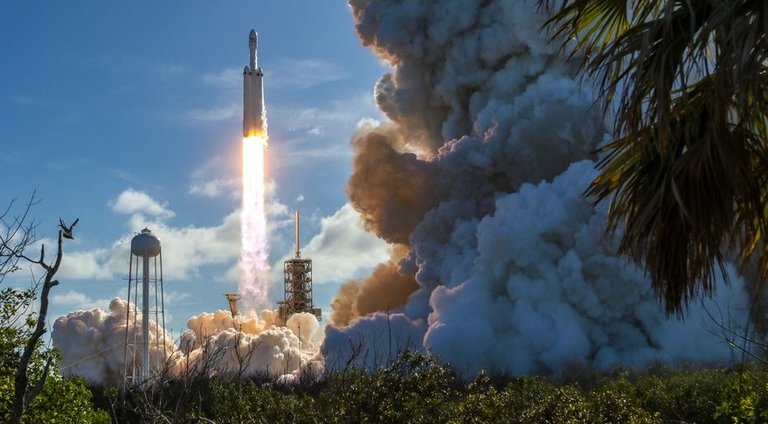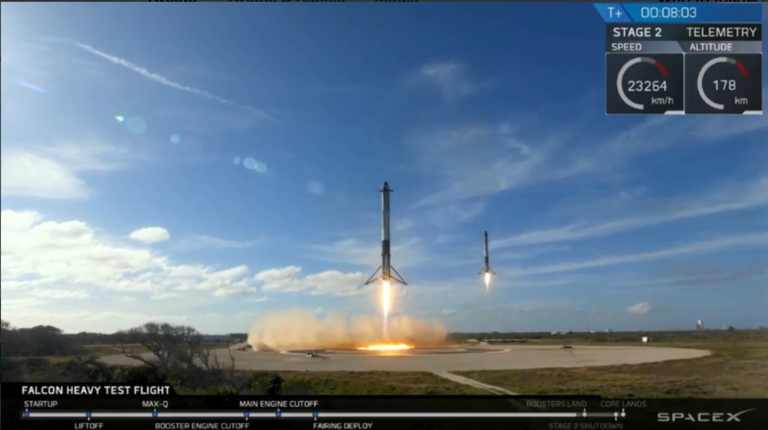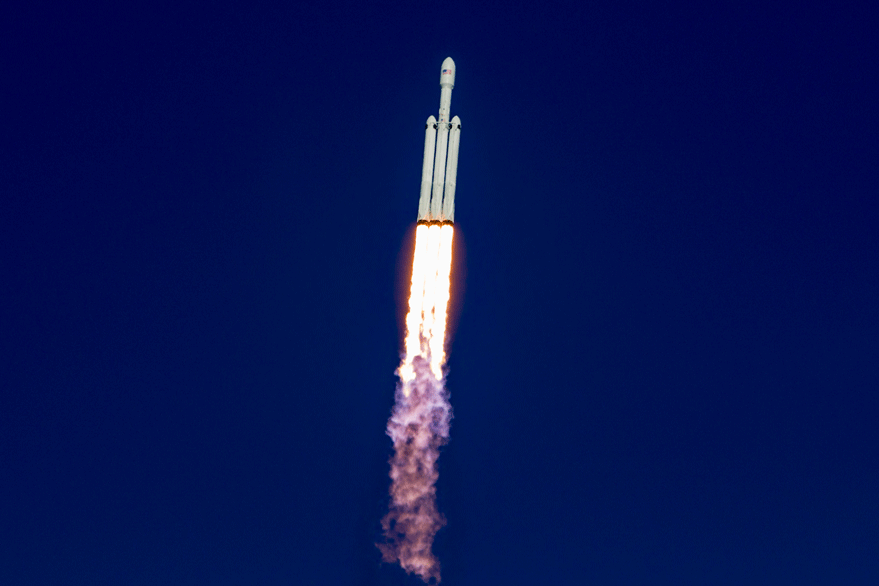
A SpaceX Falcon Heavy lifts off from Kennedy Space Center's Launch Complex 39A on its inaugural flight Feb. 6.
KENNEDY SPACE CENTER, Fla. — A SpaceX Falcon Heavy successfully launched on its inaugural flight here Feb. 6, placing a demonstration payload into orbit and boosting the company’s interplanetary ambitions.
The Falcon Heavy lifted off at 3:45 p.m. Eastern from Launch Complex 39A here, after more than two hours of delays due to high upper-level winds. The two side boosters landed at pads designated Landing Zone 1 and 2 at the former Launch Complex 13 at Cape Canaveral Air Force Station.
The upper stage performed two burns that placed itself and its demonstration payload, a modified Tesla Roadster, into an elliptical orbit of about 180 by 6,950 kilometers. A final burn about six hours after launch was designed send the payload into a heliocentric orbit between the Earth and Mars. SpaceX Chief Executive Elon Musk later tweeted that this final burn over-performed, putting the payload into an orbit that takes it out into the asteroid belt.
“I’m still trying to process everything that happened,” Musk said at a post-launch press conference here. “It seems surreal to me.”
The one setback for the launch was the failure to land the center core booster. The center core attempted to land on a drone ship downrange, but Musk said that the landing failed when only one of three engines ignited for the final landing burn.
“We hit the water at about 300 miles per hour,” he said, missing the drone ship by 100 meters. “That was enough to take out two thrusters [on the drone ship] and shower the deck with shrapnel.”

Two of Falcon Heavy’s three core stages make a synchronized landing. The third core stage was programmed to land on a droneship at sea.
Nearly cancelled
The launch is a long time in coming for SpaceX. At an April 2011 press conference, Musk said the vehicle would be ready for a first launch in 2013. Development difficulties, as well as higher priority given to the company’s Falcon 9 vehicle and Dragon spacecraft, delayed the vehicle’s first flight by several years.
Musk, at the post-launch briefing, acknowledged those issues, and revealed that he had considered cancelling the Falcon Heavy on three separate occasions because it turned out to be much harder than expected to develop the rocket.
“We tried to cancel the Falcon Heavy program three times at SpaceX because it was like, ‘Man, this is way harder than we thought,'” he said. The company had to redesign the center core booster to handle the loads, as well as the grid fins used for landings because of changes in the vehicle’s aerodynamics.
“I’m guessing our total investment is over half a billion [dollars], or more,” he said of the Falcon Heavy development cost.

Falcon Heavy climbs to orbit during its Feb. 6 debut.
Changing markets
During those delays, the launch market has evolved. Improvements in the performance of the Falcon 9 now allow it to launch large commercial communications satellites that would have previously required the Falcon Heavy. Demand for such satellites has also dropped in recent years, based on declining numbers of orders of such satellites, as commercial operators weigh the effect proposed satellite constellations, as well as smaller satellites, have on their fleet replacement plans.
Falcon Heavy is designed to place up to 64 metric tons into low Earth orbit and 26.7 metric tons into geostationary transfer orbit. Those figures, Musk said, assume using booster core based on the upgraded Block 5 version of the Falcon 9, whose first flight is later this year. This demonstration launch used older versions of the booster core with somewhat less performance.
One potential market SpaceX may be targeting for Falcon Heavy is the launch of large national security payloads. The six-hour coast of the second stage after orbit insertion will simulate a mission to insert a payload directly into geostationary orbit, Musk said in a teleconference with reporters Feb. 5. Such trajectories are used for some Air Force and National Reconnaissance Office payloads.
SpaceX would first need to be certified by the Air Force for such missions, which requires the company to perform several successful launches. Musk said at the press conference he expected to fly enough commercial launches to achieve that. “We have a number of commercial customers for Falcon Heavy,” he said. “I don’t think there will be a launch number that will be an inhibitor on the national security side.”
A former Pentagon official now advising SpaceX said that the Falcon Heavy may be compelling to the Defense Department given both its payload capacity and its low price.
“It’s really a game-changing capability,” said John Young, former undersecretary of defense for acquisition, technology and logistics, in a Feb. 6 interview prior to the launch. “The nearest peer competitor is the Delta 4 Heavy at roughly half the thrust and from four to as much as ten times the cost.”
Young said Falcon Heavy’s capacity could be of interest for proposed national security mission that can’t fly on the Delta 4 Heavy or smaller rockets. “There are communities that would like to put bigger satellites with larger apertures in space,” he said. “Falcon Heavy is extraordinarily affordable so it opens up opportunities to think about those larger satellites again.”
Falcon Heavy can serve the “modest” set of satellites that otherwise require the Delta 4 Heavy, but do so at a far lower cost. “If I was still part of the DOD acquisition team I would be enormously excited about this chance to use the savings” for other defense needs, he said.
Starman
The payload for this demonstration flight is Musk’s own red Tesla Roadster, an unconventional choice that has attracted attention and some criticism. A mannequin dubbed “Starman” wearing a spacesuit SpaceX has designed for its commercial crew program is sitting in the driver’s seat of the car.
The car should be in its heliocentric orbit for several hundred million years, Musk estimated, making multiple close passes to Mars. The car is equipped with three cameras, in addition to a large number of sensors on the upper stage. “The most fun still will be the three cameras that are mounted in the roadster,” he said Feb. 5. “They really should provide some epic views if they work and everything goes well.”
That was the case, with SpaceX offering livestreamed views from the car, and of the car from the payload adapter, for several hours after launch. The YouTube livestream attracted more than 100,000 viewers at times.
“It’s kind of silly and fun, but I think silly and fun things are important,” he said. “The imagery of it is something that’s going to get people excited around the world. It’s still tripping me out.”
Hi! I am a robot. I just upvoted you! I found similar content that readers might be interested in:
http://spacenews.com/spacex-successfully-launches-falcon-heavy/
I think I am talking to the right person, so, am I your boyfriend?
This post has received a 0.31 % upvote from @drotto thanks to: @zumerret.
This post has received a 3.16 % upvote from @steemdiffuser thanks to: @zumerret. Steem on my friend!
Above average bids may get additional upvotes from our trail members!
Get Upvotes, Join Our Trail, or Delegate Some SP
If you like this bot and want more of it, vote for my creator @isnochys as witness!This post has been upvoted by @microbot with 2.4%!
This post has received a 0.38 % upvote from @morwhale thanks to: @zumerret.
If you like this bot and want more of it, vote for my creator @isnochys as witness!This post has been upvoted by @nanobot with 5.5%!
Does anyone know about the live stream footage that was edited? They did it without mentioning it, changing various scenes of the Falcon heavy rocket launch. None of the live streamed video statistics were changed, why did they do this? See the video for yourselves and tell me what you think..... https://steemit.com/science/@surgeo/spacex-deception-editing-live-stream-footage-of-falcon-heavy-launch